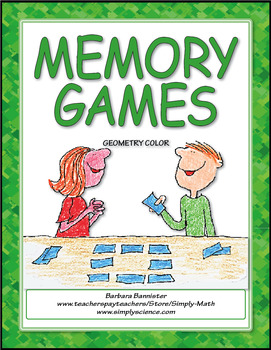Geometry Memory Games
Simply Math
285 Followers
Grade Levels
K - 6th, Homeschool
Subjects
Standards
CCSSK.G.A.2
CCSS1.G.A.1
CCSS1.G.A.2
CCSS2.G.A.1
CCSS3.G.A.1
Formats Included
- Zip
Pages
36 pages
Simply Math
285 Followers
Description
Here's a game that makes it easy to differentiate for all the students in your classroom who are learning geometry.
You can have groups practicing two-dimensional shapes or three-dimensional shapes while other groups are practicing lines, angles, or circles. Students can pick the game they want to play to help them learn their geometry terms.
The different combinations of game cards and corresponding answer keys are listed in the table of contents. Print and cut game cards on cardstock, add an answer key, tuck it all in a zip bag, and you've got a game. Set up and clean up is quick and easy.
A short video explains how to play the game with details about creating the game and a bit of strategy for winning the game.
This game is part of my primary bundle and a bundle with games about math properties, order of operations, and equivalent numbers.
If you like this game, check out the Bingo games we've included in our store.
Thanks for visiting my Simply Math store. Please take a moment to leave a comment when you purchase a product.
– • – ♥ – • –
Find amazing and creative resources for teaching science in our Simply Science store.
– • – ♥ – ♥ – ♥ – • –
Click on the ★ next to our store to follow me and find out about new products.
– • – • – ♥ – ♥ – ♥ – • – • –
Visit my blog to find resources for new teachers and "I'd like to teach more science" teachers!
The illustration of the cover of my product was created by: The Educational Graphics Group.
You can have groups practicing two-dimensional shapes or three-dimensional shapes while other groups are practicing lines, angles, or circles. Students can pick the game they want to play to help them learn their geometry terms.
The different combinations of game cards and corresponding answer keys are listed in the table of contents. Print and cut game cards on cardstock, add an answer key, tuck it all in a zip bag, and you've got a game. Set up and clean up is quick and easy.
A short video explains how to play the game with details about creating the game and a bit of strategy for winning the game.
This game is part of my primary bundle and a bundle with games about math properties, order of operations, and equivalent numbers.
If you like this game, check out the Bingo games we've included in our store.
Thanks for visiting my Simply Math store. Please take a moment to leave a comment when you purchase a product.
– • – ♥ – • –
Find amazing and creative resources for teaching science in our Simply Science store.
– • – ♥ – ♥ – ♥ – • –
Click on the ★ next to our store to follow me and find out about new products.
– • – • – ♥ – ♥ – ♥ – • – • –
Visit my blog to find resources for new teachers and "I'd like to teach more science" teachers!
The illustration of the cover of my product was created by: The Educational Graphics Group.
Total Pages
36 pages
Answer Key
N/A
Teaching Duration
N/A
Last updated May 15th, 2014
Report this resource to TPT
Reported resources will be reviewed by our team. Report this resource to let us know if this resource violates TPT’s content guidelines.
Standards
to see state-specific standards (only available in the US).
CCSSK.G.A.2
Correctly name shapes regardless of their orientations or overall size.
CCSS1.G.A.1
Distinguish between defining attributes (e.g., triangles are closed and three-sided) versus non-defining attributes (e.g., color, orientation, overall size); build and draw shapes to possess defining attributes.
CCSS1.G.A.2
Compose two-dimensional shapes (rectangles, squares, trapezoids, triangles, half-circles, and quarter-circles) or three-dimensional shapes (cubes, right rectangular prisms, right circular cones, and right circular cylinders) to create a composite shape, and compose new shapes from the composite shape.
CCSS2.G.A.1
Recognize and draw shapes having specified attributes, such as a given number of angles or a given number of equal faces. Identify triangles, quadrilaterals, pentagons, hexagons, and cubes.
CCSS3.G.A.1
Understand that shapes in different categories (e.g., rhombuses, rectangles, and others) may share attributes (e.g., having four sides), and that the shared attributes can define a larger category (e.g., quadrilaterals). Recognize rhombuses, rectangles, and squares as examples of quadrilaterals, and draw examples of quadrilaterals that do not belong to any of these subcategories.





